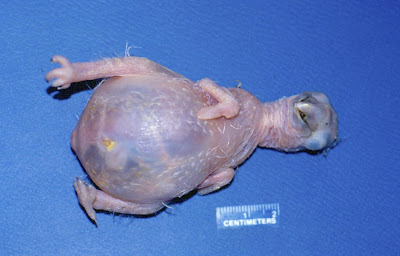Yolk Sac Infection, Omphallitis
A
condition seen worldwide in chickens, turkeys and ducks due to
bacterial infection of the navel and yolk sac of newly hatched chicks as
a result of contamination before healing of the navel. Disease occurs
after an incubation period of 1-3 days. Various bacteria may be involved, especially E .coli, Staphylococci, Proteus, Pseudomonas.
Morbidity is 1-10% and mortality is high
in affected chicks. It is seen where there is poor breeder farm nest
hygiene, use of floor eggs, inadequate hatchery hygiene or poor
incubation conditions, for example poor hygiene of hatching eggs,
'bangers', and poor hygiene of setters, hatchers or chick boxes.
Inadequate incubation conditions resulting in excessive water retention
and slowly-healing navels and 'tags' of yolk at the navel on hatching
also contribute to the problem.
Signs
- Dejection.
- Closed eyes.
- Loss of appetite.
- Diarrhoea.
- Vent pasting.
- Swollen abdomen.
- Post-mortem lesions
- Enlarged yolk sac with congestion.
- Abnormal yolk sac contents (colour, consistency) that vary according to the bacteria involved.
Diagnosis
A
presumptive diagnosis is based on the age and typical lesions.
Confirmation is by isolation and identification of the bacteria involved
in the internal lesions. Differentiate from incubation problems
resulting in weak chicks.
Treatment
Antibiotics
in accordance with sensitivity may be beneficial in the acute stages,
however the prognosis for chicks showing obvious signs is poor; most
will die before 7 days of age.
Usually
Quinolones are found to be effective antibiotics @ 1g/liter water at
early age of chicks. The quinolones (including ciprofloxacin,
levofloxacin, moxifloxacin, nalidixic acid, norfloxacin and ofloxacin)
are broad-spectrum synthetic antibiotics used in the treatment of a wide
variety of infections.
Prevention
Prevention
is based on a good program of hygiene and sanitation from the nest
through to the chick box (e.g. clean nests, frequent collection,
sanitation of eggs, exclusion of severely soiled eggs, separate
incubation of floor eggs etc. There should be routine sanitation
monitoring of the hatchery. Multivitamins in the first few days may
generally boost ability to fight off mild infections.
Tags:
Poultry

